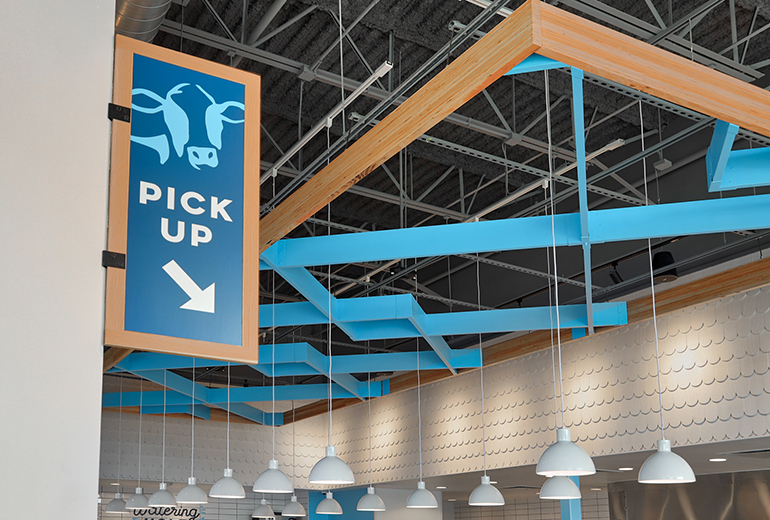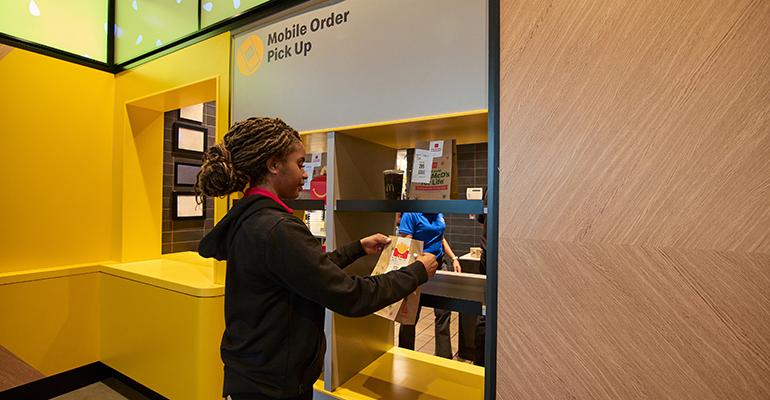Order-ahead lanes, automated drive-thru windows and special areas for to-go meal pickups are taking up more space in the ever-expanding off-premises restaurant tool kit in 2023.
As pandemic-fueled digital ordering and off-premises habits continued, restaurant brands were incorporating more to-go innovations into their designs.
At the end of 2022, McDonald’s unveiled a small-format test concept near Fort Worth, Texas, that incorporates many of the possible new strategies, targeted at the on-the-go consumer and delivery drivers.
Full-service concepts like Texas Roadhouse and Black Bear Diner were modifying lobbies to carve out pick-up windows. Chili’s Grill & Bar, the division of Brinker International Inc., opened its first delivery/carryout-only unit.

Fast-casual brands like Mendocino Farms were creating large-scale pick-up cubicles. And Chipotle Mexican Grill was expanding its Chipotlane model, noting that the convenience units generated as much as 20% more sales than traditional formats.
A few quick-service brands, including Restaurant Brands International’s Burger King and Yum Brands’ Taco Bell, were testing conveyor belts to deliver orders to automobiles at the drive-thru.
The conveyor system was among innovations in McDonald’s Fort Worth unit, which also featured an order-ahead lane in the drive-thru.
“At McDonald’s, we’ve been setting the standard for drive-thrus for more than 45 years,” said Max Carmona, McDonald’s senior director for global design and restaurant development, in a statement. “As our customers' needs continue to change, we are committed to finding new ways to serve them faster and easier than ever before.”
The unit is operated by franchisee Keith Vanecek, who noted that the separate order-ahead lane was an option for customers who want to place their order ahead of arrival through the McDonald’s app and skip the traditional drive-thru line.
“The technology in this restaurant not only allows us to serve our customers in new, innovative ways, [but it also] gives our restaurant team the ability to concentrate more on order speed and accuracy, which makes the experience more enjoyable for everyone,” Vanecek said in a statement.
Inside the unit, which is smaller than a traditional McDonald’s restaurant, it offers a kiosk for ordering, a delivery pick-up room for couriers to retrieve orders quickly and conveniently and a pick-up shelf for orders. Outside, the restaurant offers several parking spaces dedicated to curbside order pick-up and designated parking spaces for delivery drivers.

McDonald’s noted that the Fort Worth unit is fully a test location for new ideas to speed service.
The company said the order-ahead lane used technology that allows the restaurant team to begin preparing customers’ orders when they’re near the restaurant, while a new kitchen format streamlined operations.
Drive-thru technology innovations require thorough planning on the part of brand executives, said Steven Baker with Bentonville, Ark.-based HFA Architects and Engineers, which works with a number of fast-casual and quick-serve concepts.
“In our experience, these projects run most efficiently when all parties collaborate and communicate from the outset and when key questions are asked and addressed in the right order,” Baker said in a November post entitled “Reinventing QSRs — One Square Foot at a Time.”
To capitalize on off-premises demand, he noted, restaurant owners need to rethink how their sites and stores function. “For existing locations, the biggest trend is toward demolishing part or all of the dining room,” Baker said. “This frees up the square footage needed to increase back-of-house/kitchen capacity and/or support more drive-thru service.”
Baker noted a recent HFA example from the convenience-store sector that was a drive-thru-only Wawa unit in Morrisville, Pa. “The much-smaller buildings required for drive-thru-intensive prototypes can be built faster and at lower cost,” he said. “This is no small consideration given today’s steep increases in construction costs and delays.”
Baker also noted some quick-service operators have invested in higher-capacity equipment that allows them to meet growing demand without needing additional square footage in their units.
On restaurant remodels, HFA’s role includes inquiring into technical factors and constraints, such as whether the client’s proposed changes would require additional plumbing, electrical or grease-interceptor capacity. HFA engineers also communicate with municipal officials and inspectors throughout the permitting process.
Municipal parking requirements can be a factor, he added.
“When restaurants ramp up drive-thru capacity, they need to avoid demising too many parking spaces, which could violate those municipally-established parking minimums,” Baker said.
Lease terms also can be a consideration, he said.
Protective lease clauses of fellow shopping center tenants could limit options for any planned remodel. “For example, if the plan is to remove all windows from that restaurant and convert it into a drive-thru-only location, the landlord and/or co-tenants may need to give their approvals,” he said in a statement.
Potential obstacles could be related to utilities, parking ratios and lease restrictions, all of which should be addressed before renderings and detailed plans were drawn up for municipal review, he noted.

Mendocino Farms in late November opened a new unit in Dallas that emphasized its fast-casual branding and highlighted its growing off-premises sales.
The Los Angeles-based Mendocino Farms opened its 50th location in the end-cap of a strip mall. While providing no drive-thru service, it did open with plenty of parking for delivery drivers and a design that accommodated them as well as traditional dine-in and to-go customers. The brand has several delivery-only locations as well.
The latest restaurant offered a special area for pickup orders near the front entrance, allowing third-party drivers easy access near the special entrance for delivery couriers.
The pickup area was specially designed into the waist-high divider between the order line and the dining room. The area is also marked with special ceiling-mounted signage.
“Thinking about the flow of the restaurant is essential to managing a high volume of online orders and delivery pickups without congestion points or inconvenient waiting areas,” said Steve Mintzer, Mendocino Farms’ chief operating officer. “We usually consider a separate entrance for off-premises pickups when possible and have it as a commonplace feature in many of our stores.”
Designating areas within the restaurant for pickup and delivery orders also helps with the guest experience, Mintzer said, such as creating spaces and shelves within the store.
“These should be visible enough from all vantage points in the restaurant and easily accessible from any given entry points,” he added. “Having way-finding mechanisms in place can also minimize searching during peak hours, such as splitting pickup and delivery, designating third-party platforms by name and providing letter ranges for better organization.”

Ease of use by employees is also important, he added, such as making it simple for them to load the shelves.
“This also improves efficiency, accuracy and timeliness,” Mintzer said. “In some of our stores, we have pickup shelves that can be easily backfilled from the expo area so team members aren’t rushing across the restaurant to fill the shelves.”
Busy parking lots can also add difficulty, so Mendocino Farms works to provide exclusive or short-term, non-exclusive parking spaces outside of the restaurant.
Maintaining dining room standards for off-premises orders is also kept in mind, Mintzer said, especially in packaging.
“Quality shouldn’t be compromised with pickup and delivery,” he said. “Having the same standards when it comes to timeliness, accuracy, freshness and more for off-premises orders is essential to a thriving business and fanbase.”
Staff training also includes making guests and drivers feel welcome, Mintzer said.
“Off-premises dining should deliver on convenience, but it shouldn’t be devoid of soul,” he said. “At Mendocino Farms, we strive to make all guests feel welcome, so making sure to still have that ‘moment of humanity’ by acknowledging pickup guests and offering help if needed. This sentiment should also extend to third-party delivery drivers.”
As off-premises continues to contribute significantly to restaurant sales, observers said they expect to see other innovations that make the process faster and more convenient.
Contact Ron Ruggless at [email protected]
Follow him on Twitter: @RonRuggless




